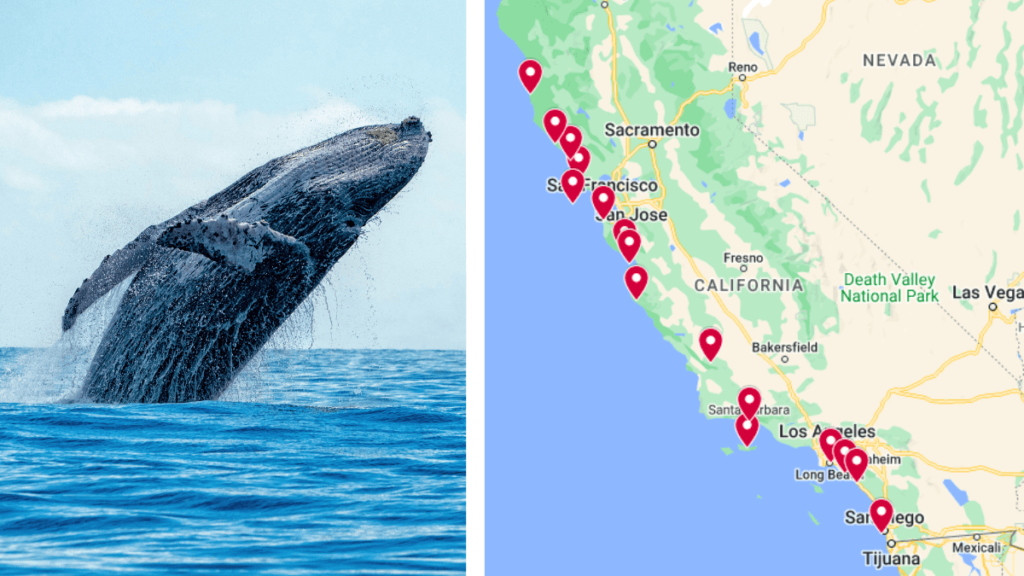California is one of the world’s best locations to do whale watching and there’s no surprise as to why.
With plenty of locations to do it throughout the state from Mendocino to San Diego, you’re never too far from a perfect whale-watching spot.
But to make sure you get the best chance of seeing your favourite type of whale you need to know the best times to visit or you might miss the whales on their journeys.
In this post, we’ll cover 16 locations where you can see whales in California.
We’ll also tell you:
- The best times to visit
- Specific viewpoints and tours to get the best experience
- Types of whales you could see at each location
Are you ready to discover these whale-watching secrets?
TIP!
Don’t forget to get binoculars for the best experience, ESPECIALLY if you are watching from the shore.
1. Monterey Bay
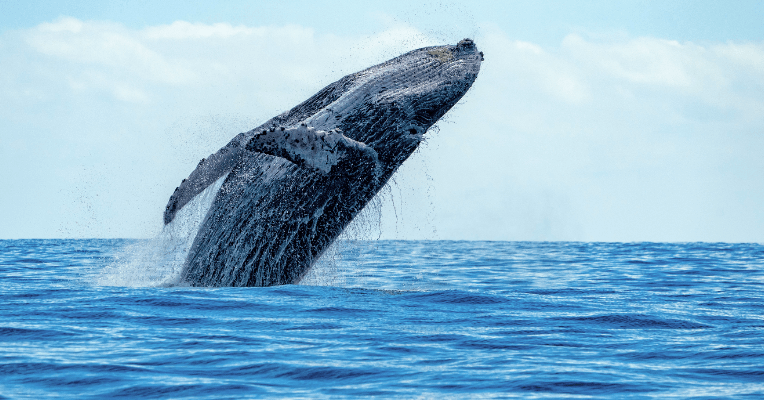
Best Time to Visit
Monterey Bay is a fantastic whale-watching destination throughout the year. Different seasons offer opportunities to see various whale species.
For most types of Whales, August is one of the best months to see them (unless you want to see Gray Whales).
Winter (December to May): Ideal for spotting humpback and gray whales.
Spring to Fall (April to November): Peak season for observing whales breaching and feeding, with humpback whales being a common sight.
Specific Months for Various Whales:
Blue whales: May to October (peaks in July-August).
Killer whales (Orcas): Mid April-Mid May, Late August-October.
Gray whales: December-May (peaks in January and March).
Humpback whales: March-November (peaks in July-August).
Best Locations/Viewpoints
Monterey Bay itself is renowned for its deep submarine canyon, making it an excellent habitat for many whale species.
Whale-watching tours frequently depart from Moss Landing Harbor, the closest port to the Monterey Submarine Canyon.
Point Lobos State Natural Reserve: Known for its remarkable beauty and oceanic wildlife, including sea lions, harbor seals, elephant seals, and sea otters.
Orcas are a year-round attraction here, and gray whales migrate past this area from December to April, visible from the shore.
Moss Landing: Offers whale watching tours that provide an excellent opportunity to spot various whales and other marine wildlife.
The harbor is a prime location for starting whale-watching tours due to its proximity to the Monterey Submarine Canyon. Operators include the likes of Sea Goddess Whale Watching and Blue Ocean Whale Watching
Whale Watching Tours From Fisherman’s Wharf:
There are a few tours that run from Fisherman’s Wharf that give you a unique experience on the water so you don’t have to watch from the shore.
Here’s a highly recommended tour:
Types of Whales You’ll See
Blue Whales: Best seen from May to October.
Killer Whales (Orcas): Best observed from mid-April to mid-May, and late August to October.
Gray Whales: Commonly seen from December to May.
Humpback Whales: Frequently spotted from March to November.
Other species such as fin, minke, sperm, and the rarely observed beaked whale might also make appearances.
2. Newport Beach
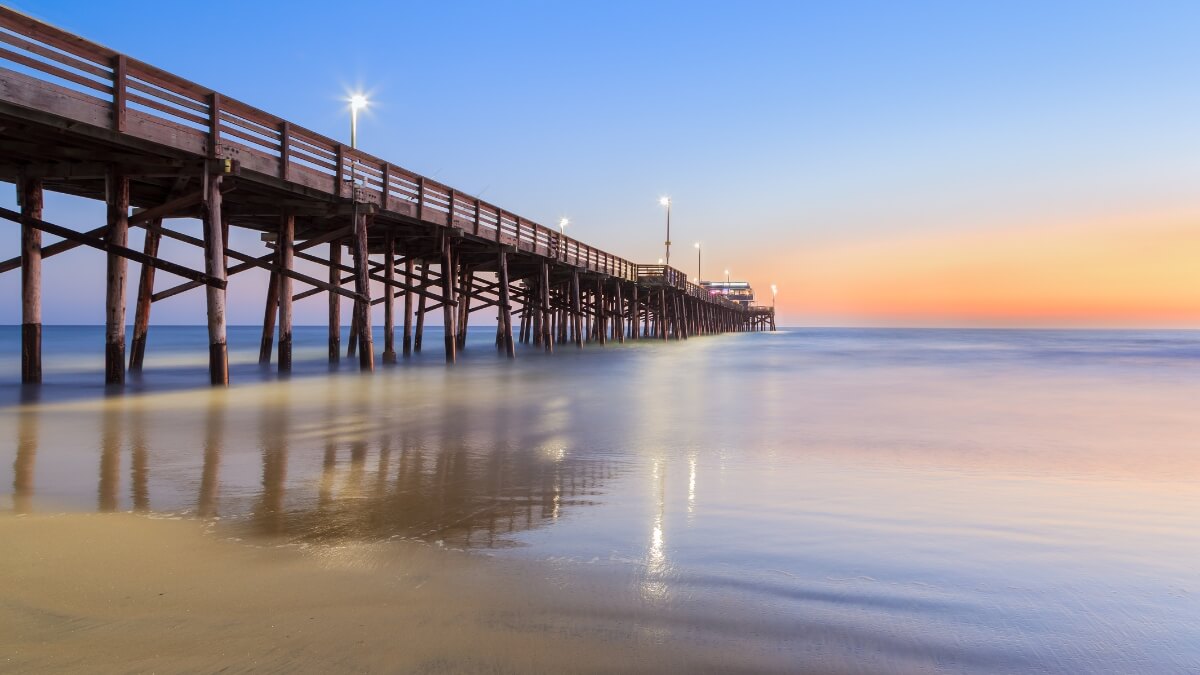
Best Time to Visit
Gray Whale Migration (Mid-December to Mid-April): This is the peak season for whale watching in Newport Beach, where you can observe gray whales traveling to their breeding grounds in Mexico.
February/March and September: These months are historically peak whale-watching periods for various whale types.
May through November: These warmer months provide opportunities to view blue whales.
Best Locations/Viewpoints
While whale watching in Newport Beach typically involves boat tours, there are several companies offering these experiences so you’ll be spoilt for choice:
- *Davey’s Locker (highly recommended tour)
- East Meets West Whale Watching
- Newport Surfrider
- Newport Landing Whale Watching
- Captain Frank’s Sailing Adventures
Types of Whales You’ll See
Grey Whales: Most commonly seen during their migration from December to April.
Blue Whales: Typically spotted in warmer waters from May through November.
Humpback Whales and Killer Whales: While less common, these species can also be observed in the waters around Newport Beach
3. Dana Point
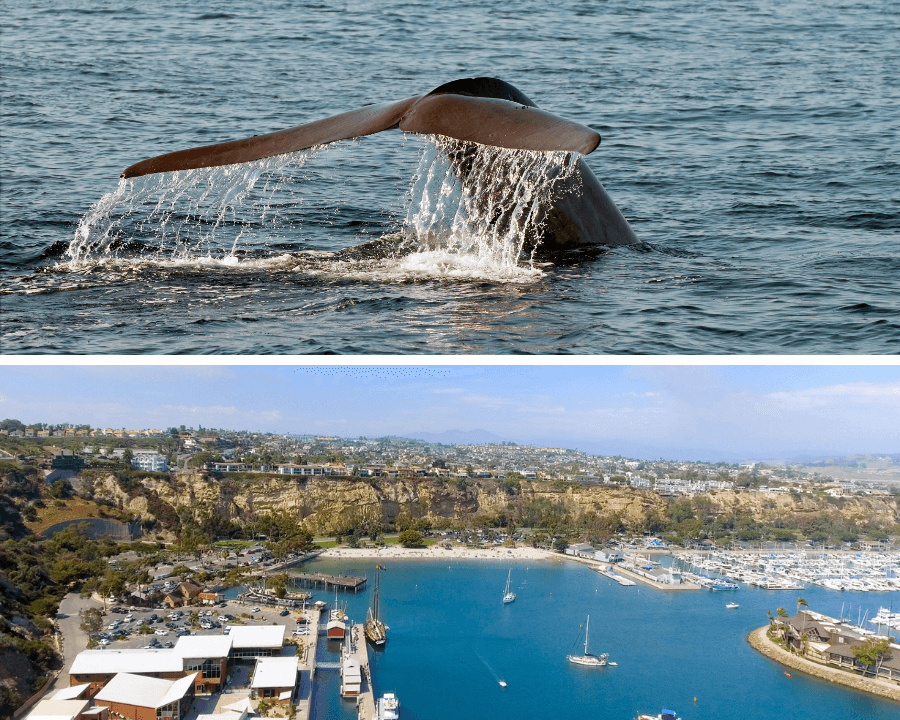
Best Time to Visit
Dana Point offers fantastic whale watching year-round, but the best times to visit depend on the type of whales you want to see:
Blue Whales: Best seen during summer and fall, typically from May to October.
Gray Whales: Visit from December to April during their migration from Alaska to Mexico.
Dolphins: Commonly seen throughout the year, with large pods often spotted near Dana Point.
Best Locations/Viewpoints
Dana Point Harbor: Numerous whale-watching tours depart from here, offering excellent opportunities to spot whales and dolphins.
Headlands Conservation Area: Offers elevated views of the Pacific Ocean, perfect for observing migrating whales.
Strand Beach: A more relaxed spot for shore-based whale watching. Bring binoculars for better views.
Whale Watching Tours: During migration season whale watching tours are quite common.
I recommend this highly rated whale watching tour in Dana Point:
Types of Whales You’ll See
Blue Whales: Known for their immense size, they are the largest animals on earth and frequent the area during summer and fall.
Gray Whales: Commonly seen from December to April during their long migration.
Humpback Whales: Known for their acrobatic displays and fluke diving, they are spotted occasionally during the year.
Orcas (Killer Whales): These apex predators make rare but thrilling appearances.
Dolphins: Various species of dolphins, including common dolphins and bottlenose dolphins, are seen year-round.
4. San Diego and Cabrillo National Monument
Best Time to Visit
The prime time for whale watching in San Diego is during the winter and spring months, specifically from December to April with mid-January being the peak time for migration.
This period corresponds to the annual gray whale migration when these magnificent creatures pass by the San Diego coast on their way to and from the breeding lagoons in Baja, Mexico.
Best Locations/Viewpoints
San Diego offers numerous excellent locations and viewpoints for whale watching, including:
Cabrillo National Monument: Located on the Point Loma Peninsula, it provides panoramic views of the Pacific Ocean, making it an ideal spot for observing gray whales during their migration.
In particular, these spots are good:
- Kelp Forest Overlook
- Old Point Loma Lighthouse
- Whale Overlook
Birch Aquarium at Scripps: Offers both indoor and outdoor observation decks for a unique perspective on whale watching.
The aquarium also provides educational programs and exhibits about marine life.
La Jolla Cove: Known for its crystal-clear waters, this area often provides opportunities to spot whales and other marine life from the shoreline or nearby cliffs.
Whale-Watching Tours: Several tour operators offer boat trips specifically for whale-watching.
These tours give you the chance to get up close to the whales and other marine animals without having to worry about finding the best locations.
I’d recommend this highly rated whale watching tour in San Diego:
Types of Whales You’ll See
The primary whale species you can expect to see in San Diego are:
Gray Whales: San Diego is a crucial stopover for gray whales during their migration. You may witness these gentle giants on their journey to and from the breeding grounds in Mexico.
Blue Whales: The world’s largest animals, blue whales, are occasionally spotted off the San Diego coast, especially during the summer months.
Humpback Whales: Known for their acrobatic displays, humpback whales can also be seen during the migration season.
5. Mendocino Coast
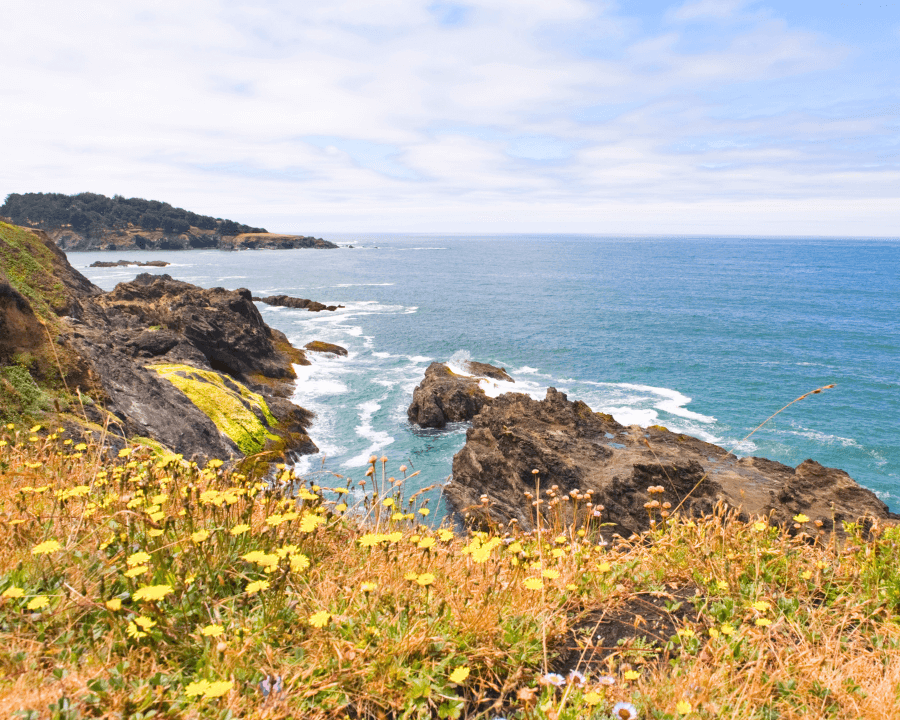
Best Time to Visit:
Gray Whales: November – May
Humpback Whales: April – November
Blue Whales: June – October
The perfect time to see whales in Mendocino is around March as you could catch both Gray Whales and Humpback Whales.
This is also when you can join the fun Mendocino Whale Festivals in nearby towns like Mendocino, Little River, and Fort Bragg.
Best Locations/Viewpoints:
Mendocino Headlands State Park: Walk along the coast and look out for whales.
Point Arena Lighthouse: Stand here for a great view of the ocean and whales. (This is one of the best spots)
Other Spots:
- Check out Chapman Point
- Spring Ranch Headlands at Van Damme State Park
- Point Cabrillo Light Station
- Mendocino Coast Botanical Gardens
- Noyo Bluffs
- MacKerricher State Park at Laguna Point.
Types of Whales You’ll See:
The main attraction at Mendocino Coast is the Pacific Gray Whale.
These whales pass by the coast twice each year, during their migration between Alaska and Baja, Mexico.
While the Pacific Gray Whale is the most common, you might also catch glimpses of humpback whales, killer whales (orcas), and blue whales, especially around Point Arena Lighthouse.
TIP!
Don’t forget to get binoculars for the best experience, ESPECIALLY if you are watching from the shore.
Here are some recommendations below:
– Best Overall -> Bushnell Engage Binoculars 8×42 Binoculars
– More Affordable -> Celestron Ultima 8×42 Binoculars
6. Salt Point State Park

Best Time to Visit
The best time for whale watching at Salt Point State Park is from December to April.
During these months, gray whales migrate along the Sonoma Coast, offering excellent opportunities for sightings.
Best Locations/Viewpoints
Salt Point State Park is known for its scenic beauty and a network of trails offering panoramic ocean views, which are great for whale watching:
Salt Point Trail: A three-mile roundtrip trail that runs parallel to the Pacific Ocean, providing coastal views and opportunities to spot whales.
Types of Whales You’ll See
Gray Whales: The annual north-to-south gray whale migration peaks during the winter months along the Sonoma County coast.
This makes winter an ideal time for spotting these majestic creatures at Salt Point State Park.
7. Bodega Bay
Best Time to Visit
The ideal time for whale watching in Bodega Bay spans different seasons:
Winter to Spring (December to May): This period is best for spotting gray whales and orcas.
Gray whales, often with their offspring, are frequently seen during these months, especially during their northbound migration from March to June.
Summer to Fall (May to November): These months are great for observing humpback whales.
In summer and fall, you can also spot blue whales, known for their massive size.
Best Locations/Viewpoints
Bodega Bay offers several prime locations for whale watching:
Bodega Head: A small peninsula extending into the ocean, providing an excellent vantage point.
Volunteers from the Whale Watch Public Education Program are available on weekends from January through Mother’s Day to share knowledge and answer questions.
Gualala Point Regional Park: Offers expansive beaches and trails with stunning vistas, ideal for winter whale watching.
Stillwater Cove Regional Park: Known for its sweeping ocean views and trails such as the Stillwater Bluff Trail, which is a great lookout point during whale migration season.
Fort Ross State Historic Park: Surrounded by beautiful beaches and coves, this park offers scenic views of whales during their migration.
Types of Whales You’ll See
Several whale species frequent Bodega Bay so you could be lucky enough to spot these:
Gray Whales: Common in winter and spring, often seen with their offspring.
Humpback Whales: Known for their dynamic behavior, seen primarily in spring, summer, and fall.
Blue Whales: The largest animals on earth, usually appearing offshore in summer and fall.
Killer Whales (Orcas): More often sighted recently, especially between June and December, though they are rarer than humpback and gray whales.
Minke Whales: Smaller and less frequently seen, primarily traveling in summer and fall.
8. Point Reyes National Seashore
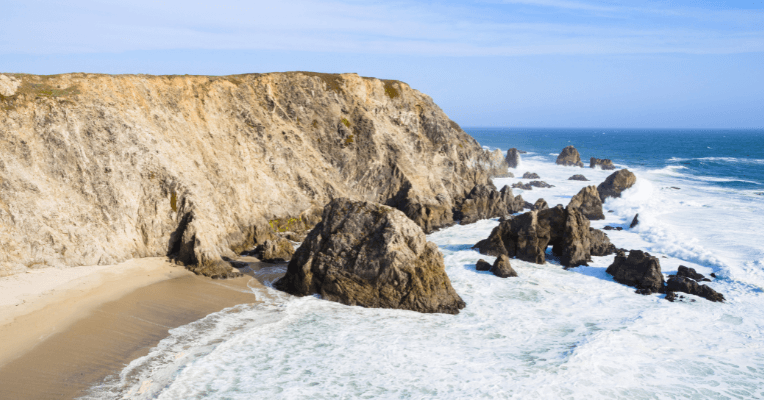
Best Time to Visit
The prime months for whale watching at Point Reyes are December to May.
January sees the highest number of whales, with over 1,000 passing each day.
Late April and early May are particularly special for seeing mothers and calves, who swim closer to shore during this period.
Best Locations/Viewpoints
The Point Reyes peninsula extends 10 miles into the Pacific Ocean, bringing you closer to migrating whales. The best spots for whale watching are:
Point Reyes Lighthouse: Offers an elevated view over the ocean.
Chimney Rock trail: Another high vantage point ideal for spotting whales.
Tomales Point Trail: Provides a unique perspective of the migrating whales.
Types of Whales You’ll See
Whale sightings at Point Reyes vary by season:
Summer or Fall: You might see humpback whales, blue whales, and fin whales.
Winter/Spring: Gray whales are the most common during these months.
Year-Round: Minke whales and orcas (part of the dolphin family) can also be spotted.
9. San Francisco Bay Area (Farallon Islands)

Best Time to Visit
Like with the other places on this list it does depend on what you want to see
- Humpback Whale – May through November
- Gray Whale – December through May
- Sperm Whale – December through May
- Orcas – December through May
- Blue Whale – July through October
One of the best times to get a chance to see different types of whales is in May (unless you want to see Blue Whales).
Additionally, there is a high chance (96%) of seeing whales from April through November, and January is also noted as a good month for whale watching during whale migration.
Best Locations/Viewpoints
Farallon Islands:
Whale watching in the Farallon Islands is typically done via boat tours, as the islands themselves are remote and not accessible for casual visits.
These tours often include cruising under the Golden Gate Bridge and are led by wildlife experts.
Oceanic Society, with over five decades of experience, offers day-long outings to the Farallones.
These trips provide opportunities to see whales, sea lions, and seabirds, enhanced by the insights of knowledgeable guides and professional wildlife photographers.
Point Bonita Lighthouse: This lighthouse from the 1800s has helped ships navigate the Golden Gate strait and it’s currently maintained by the Coast Guard.
If you can make the hike up the Point Bonita Trail then you’ll be rewarded with amazing views into open water.
Types of Whales You’ll See
Blue Whales: The largest animals ever known to have existed, they visit the Farallon Islands during the summer and early fall to feed on krill.
The upwelling of cold, nutrient-rich water in this area stimulates the growth of phytoplankton, which in turn supports large populations of krill, the primary food source for blue whales.
Humpback Whales: Known for their acrobatic behavior, humpbacks are also commonly seen feeding in the area, particularly when krill populations are high.
You also have a chance to see Gray Whales, Sperm Whales and Orcas.
Other marine mammals, such as different species of dolphins and seals, can also be observed in the area.
10. Half Moon Bay
Best Time to Visit
January to March: This period is ideal for observing gray whales as they migrate south from the Arctic to the warm lagoons of Baja, California.
March to April: A great time to spot humpback whales as they begin moving closer to the shore.
Year-Round Sightings: Humpback whales are present in this area throughout the year, and blue whales can be seen from early summer through fall.
Best Locations/Viewpoints
The coastal bluffs of Half Moon Bay provide excellent viewing opportunities.
You can spot whales from various bluff accesses along the Coastside from Montara to south of Half Moon Bay.
Here’s some spots you can try:
- Gray Whale Cove State Beach
- Devil’s Slide Trail
- Moss Beach Bluffs
- Pillar Point Bluff
- Half Moon Bay State Beach
Types of Whales You’ll See
Gray Whales: Common during their migration from the Bering Sea to Baja, with the full round-trip being the longest known migration for any mammal.
They can be seen from the kelp beds to the horizon.
Humpback Whales: Known for their captivating behaviors, these whales are most common off the coast from April through November.
Other marine mammals like harbor porpoises, sea lions, dolphins, elephant seals, and California sea lions are also frequently sighted during whale-watching excursions.
11. Santa Cruz
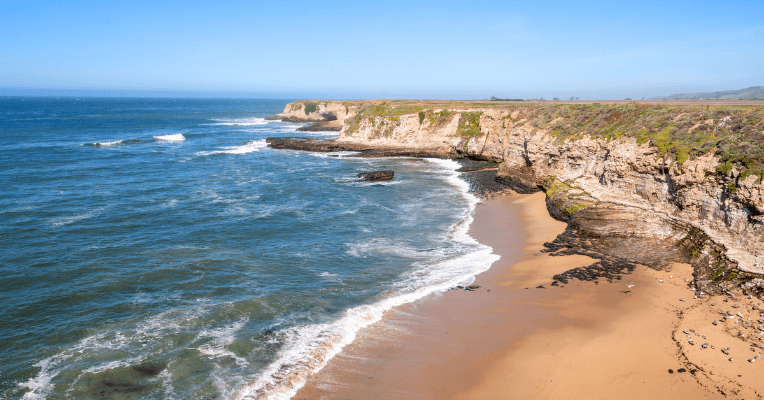
Best Time to Visit
Mid-January to April: This is the peak time for whale watching in Santa Cruz.
The peak for northbound gray whales is around mid-March, while blue whales are typically seen in the bay area during the summer months.
April to November: Humpback whales, the most common whale species in this area, are usually seen from April through November.
Best Locations/Viewpoints
While whales can be spotted off the shores of Santa Cruz year-round, the best chances to see them from shore are during the gray whale migration from December to April.
Good vantage points include West Cliff Drive, Wilder Ranch State Park, and Año Nuevo State Park.
Types of Whales You’ll See
Santa Cruz, located within the Monterey Bay, is a hub for diverse marine life.
You can see up to seven different species of whales and dolphins year-round.
Humpback Whale: Commonly seen from April through November.
Gray Whales: Over 20,000 gray whales pass through the waters off Santa Cruz from December through April.
In addition to these, visitors may also spot sea lions, seals, otters, various species of sea birds, and occasionally other marine creatures like sea turtles, jellyfish, sunfish, and sharks
12. Big Sur
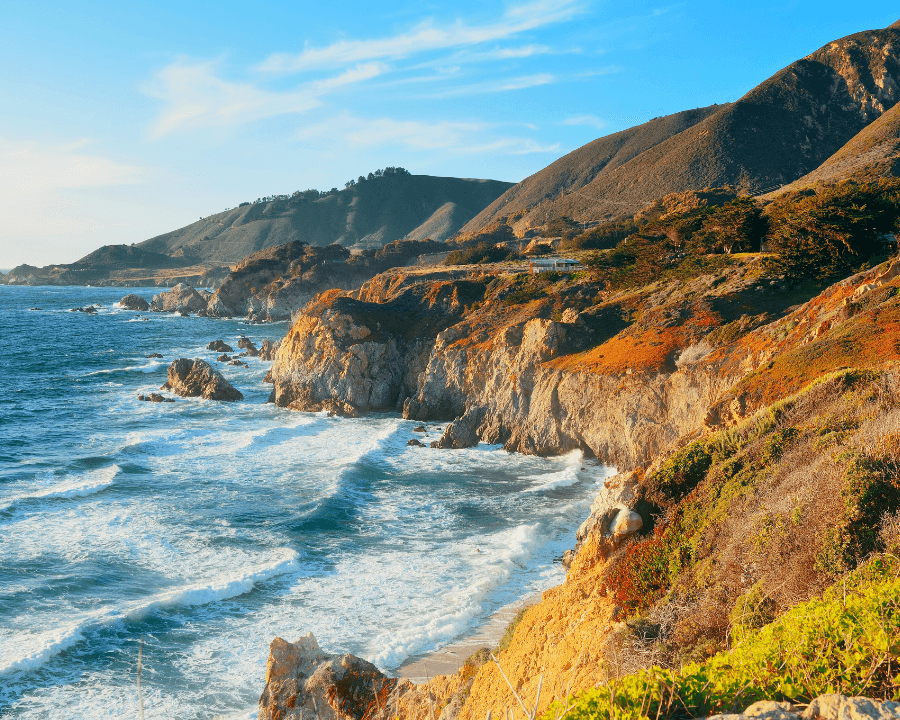
Best Time to Visit
Big Sur offers different whale-watching experiences throughout the year:
Summer Months (June to October): This is the ideal time for observing blue and humpback whales as they migrate along the coast.
Blue whales are especially visible during times of abundant krill.
Winter Months (December to April): Gray whales migrate past Big Sur’s coastline.
These months offer the best opportunity to spot these magnificent creatures.
Best Locations/Viewpoints
There are several spots along Big Sur where you can enjoy whale watching:
Granite Canyon Bridge: A known location for spotting humpback whales, especially in the summer months. Whales can often be seen from various stops along Highway 1.
Soberanes Canyon Trailhead: Offers stunning views over the Pacific Ocean and is a great spot for whale watching. It’s also a scenic hike through the trees.
Castle Rock Viewpoint and Bixby Creek Bridge: Provides expansive views of the ocean and is an excellent place for whale sightings.
It’s located just before the iconic Bixby Creek Bridge.
Types of Whales You’ll See
Blue Whales: Visible mainly from June through October, blue whales are drawn to the area due to the abundance of krill, their primary food source.
Humpback Whales: Known for their acrobatic behaviors, humpback whales can be seen in Big Sur during the summer months.
Gray Whales: These whales migrate past the Big Sur coastline from November to April.
They are especially visible during their northbound migration in the winter and early spring.
13. San Luis Obispo County
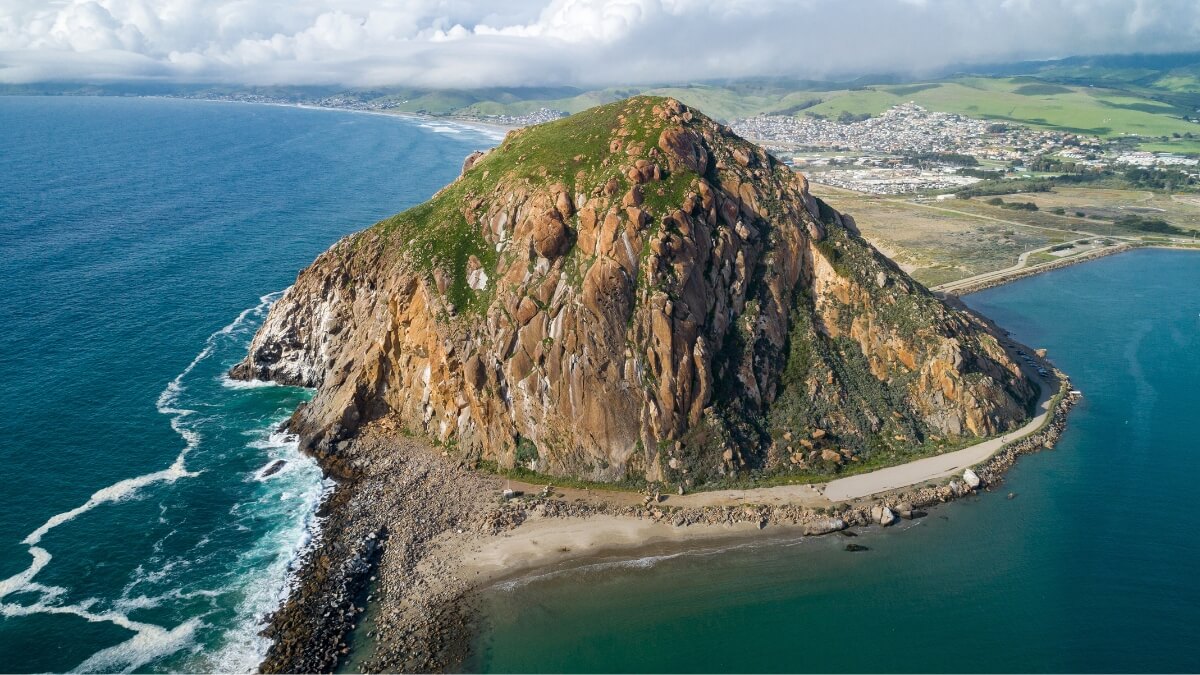
Best Time to Visit
April through November: This period is prime for Humpback Whale sightings.
January through March: Ideal for observing Grey Whales.
The months of June, August, September, October, and November are particularly notable for high whale sighting rates during tours.
So basically most of the year.
Best Locations/Viewpoints
For those seeking to experience whale watching from the shore in San Luis Obispo County, some key spots include:
- Avila Beach
- Pismo Beach, Shell Beach
- Morro Bay
These locations, accessible via Highway 1, offer great opportunities for land-based whale watching.
Additionally, several companies in Avila Beach and Morro Bay provide whale-watching tours, offering a closer view of these majestic creatures.
Types of Whales You’ll See
Whale species commonly seen along the San Luis Obispo County coastline include:
Gray Whales: The most frequently spotted species, seen especially during their migration south between December and February and north between March and May.
Blue Whales and Humpback Whales: They arrive in April as the water warms and are visible through the warmer months.
Killer whales, although less common, have also been occasionally spotted in the area.
These whales can be observed engaging in behaviors such as breaching, blowing, and lobtailing, providing a fascinating spectacle for viewers
14. Santa Barbara
Best Time to Visit
February to April: Ideal for spotting gray whales.
May to September: Best time for observing blue whales, minke whales, and humpback whales. Orcas and right whales may also be seen occasionally.
Best Locations/Viewpoints
However, the general area of the Santa Barbara Channel is a popular region for whale-watching tours.
Many of these tours depart from the Santa Barbara Harbor, providing opportunities to see a variety of whale species in their natural habitat.
Types of Whales You’ll See
Gray Whales: Commonly seen during the winter and early spring months.
Blue Whales and Humpback Whales: Frequently observed from late spring through early fall.
Minke Whales and Fin Whales: Also present in the area, along with various species of dolphins.
15. Channel Islands National Park
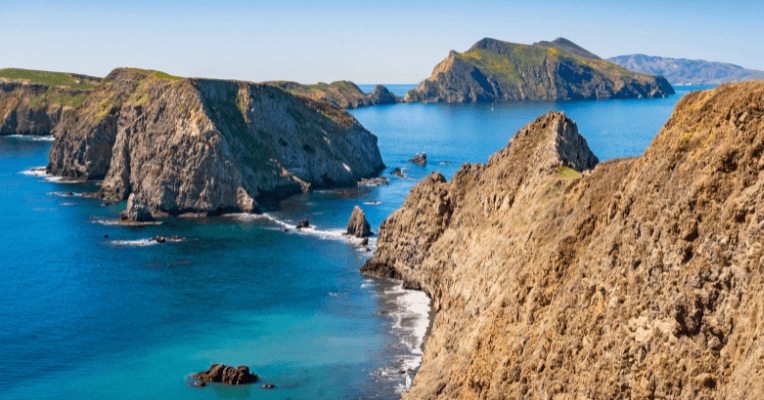
Best Time to Visit
Whale watching at the Channel Islands can be enjoyed year-round, but certain seasons are ideal for specific species:
Gray Whales: Best viewed from mid-December through mid-March.
Blue and Humpback Whales: Common during the summer months.
Common Dolphins: Visible throughout the year.
Best Locations/Viewpoints
The Channel Islands offer both shore and boat-based viewing opportunities:
Boat Tours: Island Packers and Channel Islands Sportfishing offer whale-watching cruises, providing an up-close experience.
Shore Viewing: The best shore viewing spots are high points on peninsulas that extend into the ocean. Examples include:
- Point Dume in Malibu
- Palos Verdes Peninsula near Los Angeles
- Point Loma in San Diego
- The park visitor center also features a tower with telescopes for whale watching
Types of Whales You’ll See
The Channel Islands are home to a diverse array of cetacean species:
- Gray
- Blue
- Humpback
- Minke
- Sperm
- Pilot Whales (rare in other places)
- Orcas (Killer Whales)
There are also a lot of Dolphin Species including Dall’s porpoise, Risso’s, Pacific white-sided, common, and bottlenose dolphins.
16. Long Beach
Best Time to Visit
The ideal time for whale watching in Long Beach is during the winter and spring months, from January to March-April.
This period is particularly good for observing gray whales as they migrate from the Arctic towards the western coast of Mexico.
Additionally, November to March is also favorable for spotting humpback and minke whales, dolphins, and sea lions.
Best Locations/Viewpoints
In Long Beach, you have options for both land-based and boat-based whale watching:
- ShoreLine Aquatic Park
- Alamitos Beach
- Long Beach City
These locations offer a free, relaxed experience on the waterfront with views from scenic piers and sandy beaches.
It’s recommended to bring binoculars and choose a clear day for the best chances of spotting whales from shore.
To have a higher chance of seeing the whales you’ll want to get out onto the water though by taking a boat tour.
These normally last 2-3 hours and you’ll have an expert guide you around so you can get the most out of the experience.
Types of Whales You’ll See
Long Beach is a prime location for spotting a variety of whale species, thanks to its position along the migration route between Alaska and Mexico. You can expect to see:
Pacific Grey Whales: Especially during their migration period.
Fin Whales and Humpback Whales: Visible during certain times of the year.
Orcas and Blue Whales: Although less common, these magnificent creatures can also be spotted in the waters near Long Beach

